Java基础11集合(collection接口)

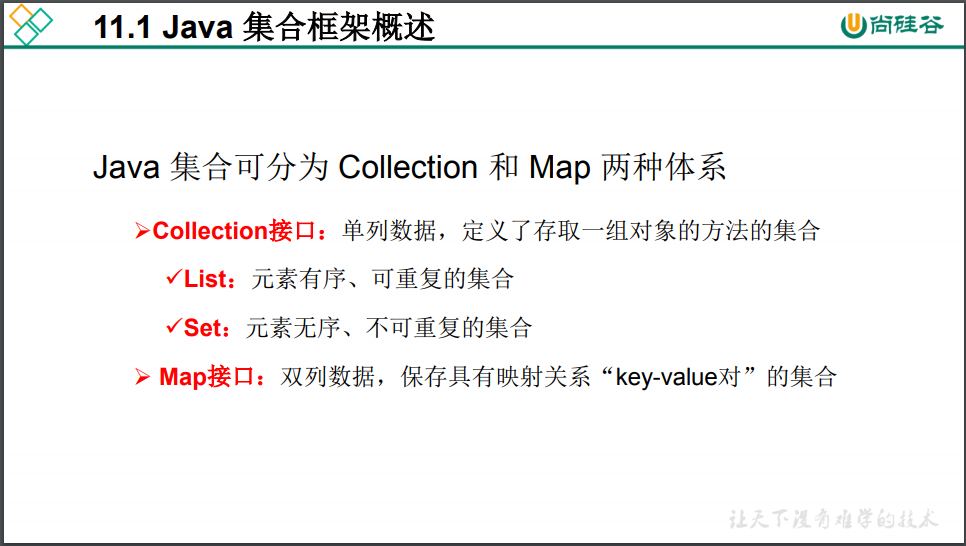



package com.atguigu.java2; import org.junit.Test; import java.util.ArrayList; import java.util.Collection; import java.util.Date; /** * 一、集合框架的概述 * * 1.集合、数组都是对多个数据进行存储操作的结构,简称Java容器。 * 说明:此时的存储,主要指的是内存层面的存储,不涉及到持久化的存储(.txt,.jpg,.avi,数据库中) * * 2.1 数组在存储多个数据方面的特点: * > 一旦初始化以后,其长度就确定了。 * > 数组一旦定义好,其元素的类型也就确定了。我们也就只能操作指定类型的数据了。 * 比如:String[] arr;int[] arr1;Object[] arr2; * 2.2 数组在存储多个数据方面的缺点: * > 一旦初始化以后,其长度就不可修改。 * > 数组中提供的方法非常有限,对于添加、删除、插入数据等操作,非常不便,同时效率不高。 * > 获取数组中实际元素的个数的需求,数组没有现成的属性或方法可用 * > 数组存储数据的特点:有序、可重复。对于无序、不可重复的需求,不能满足。 * * 二、集合框架 * |----Collection接口:单列集合,用来存储一个一个的对象 * |----List接口:存储有序的、可重复的数据。 -->“动态”数组 * |----ArrayList、LinkedList、Vector * * |----Set接口:存储无序的、不可重复的数据 -->高中讲的“集合” * |----HashSet、LinkedHashSet、TreeSet * * |----Map接口:双列集合,用来存储一对(key - value)一对的数据 -->高中函数:y = f(x) * |----HashMap、LinkedHashMap、TreeMap、Hashtable、Properties * * * 三、Collection接口中的方法的使用 * * @author shkstart * @create 2019 下午 4:08 */ public class CollectionTest { @Test public void test1(){ Collection coll = new ArrayList(); //add(Object e):将元素e添加到集合coll中 coll.add("AA"); coll.add("BB"); coll.add(123);//自动装箱 coll.add(new Date()); //size():获取添加的元素的个数 System.out.println(coll.size());//4 //addAll(Collection coll1):将coll1集合中的元素添加到当前的集合中 Collection coll1 = new ArrayList(); coll1.add(456); coll1.add("CC"); coll.addAll(coll1); System.out.println(coll.size());//6 System.out.println(coll); //clear():清空集合元素 coll.clear(); //isEmpty():判断当前集合是否为空 System.out.println(coll.isEmpty()); } }

package com.atguigu.java; import org.junit.Test; import java.util.ArrayList; import java.util.Arrays; import java.util.Collection; import java.util.List; /** * Collection接口中声明的方法的测试 * * 结论: * 向Collection接口的实现类的对象中添加数据obj时,要求obj所在类要重写equals(). * * @author shkstart * @create 2019 上午 10:04 */ public class CollectionTest { @Test public void test1(){ Collection coll = new ArrayList(); coll.add(123); coll.add(456); // Person p = new Person("Jerry",20); // coll.add(p); coll.add(new Person("Jerry",20)); coll.add(new String("Tom")); coll.add(false); //1.contains(Object obj):判断当前集合中是否包含obj //我们在判断时会调用obj对象所在类的equals()。 boolean contains = coll.contains(123); System.out.println(contains);//true System.out.println(coll.contains(new String("Tom")));//true // System.out.println(coll.contains(p));//true System.out.println(coll.contains(new Person("Jerry",20)));//false -->true 自定义类person重写equals之前调用的是obje里的equals,重写之后就变true了。 //2.containsAll(Collection coll1):判断形参coll1中的所有元素是否都存在于当前集合中。 Collection coll1 = Arrays.asList(123,4567); System.out.println(coll.containsAll(coll1)); } @Test public void test2(){ //3.remove(Object obj):从当前集合中移除obj元素。 Collection coll = new ArrayList(); coll.add(123); coll.add(456); coll.add(new Person("Jerry",20)); coll.add(new String("Tom")); coll.add(false); coll.remove(1234); System.out.println(coll); coll.remove(new Person("Jerry",20)); System.out.println(coll); //4. removeAll(Collection coll1):差集:从当前集合中移除coll1中所有的元素。 Collection coll1 = Arrays.asList(123,456); coll.removeAll(coll1); System.out.println(coll); } @Test public void test3(){ Collection coll = new ArrayList(); coll.add(123); coll.add(456); coll.add(new Person("Jerry",20)); coll.add(new String("Tom")); coll.add(false); //5.retainAll(Collection coll1):交集:获取当前集合和coll1集合的交集,并返回给当前集合 // Collection coll1 = Arrays.asList(123,456,789); // coll.retainAll(coll1); // System.out.println(coll); //6.equals(Object obj):要想返回true,需要当前集合和形参集合的元素都相同。 Collection coll1 = new ArrayList(); coll1.add(456); coll1.add(123); coll1.add(new Person("Jerry",20)); coll1.add(new String("Tom")); coll1.add(false); System.out.println(coll.equals(coll1)); } @Test public void test4(){ Collection coll = new ArrayList(); coll.add(123); coll.add(456); coll.add(new Person("Jerry",20)); coll.add(new String("Tom")); coll.add(false); //7.hashCode():返回当前对象的哈希值 System.out.println(coll.hashCode()); //8.集合 --->数组:toArray() Object[] arr = coll.toArray(); for(int i = 0;i < arr.length;i++){ System.out.println(arr[i]); } //拓展:数组 --->集合:调用Arrays类的静态方法asList() List<String> list = Arrays.asList(new String[]{"AA", "BB", "CC"}); System.out.println(list); List arr1 = Arrays.asList(new int[]{123, 456}); System.out.println(arr1.size());//1 List arr2 = Arrays.asList(new Integer[]{123, 456}); System.out.println(arr2.size());//2 //9.iterator():返回Iterator接口的实例,用于遍历集合元素。放在IteratorTest.java中测试 } }

package com.atguigu.java; import java.util.Objects; /** * @author shkstart * @create 2019 上午 10:06 */ public class Person { private String name; private int age; public Person() { } public Person(String name, int age) { this.name = name; this.age = age; } public String getName() { return name; } public void setName(String name) { this.name = name; } public int getAge() { return age; } public void setAge(int age) { this.age = age; } @Override public String toString() { return "Person{" + "name='" + name + '\'' + ", age=" + age + '}'; } @Override public boolean equals(Object o) { System.out.println("Person equals()...."); if (this == o) return true; if (o == null || getClass() != o.getClass()) return false; Person person = (Person) o; return age == person.age && Objects.equals(name, person.name); } @Override public int hashCode() { return Objects.hash(name, age); } }
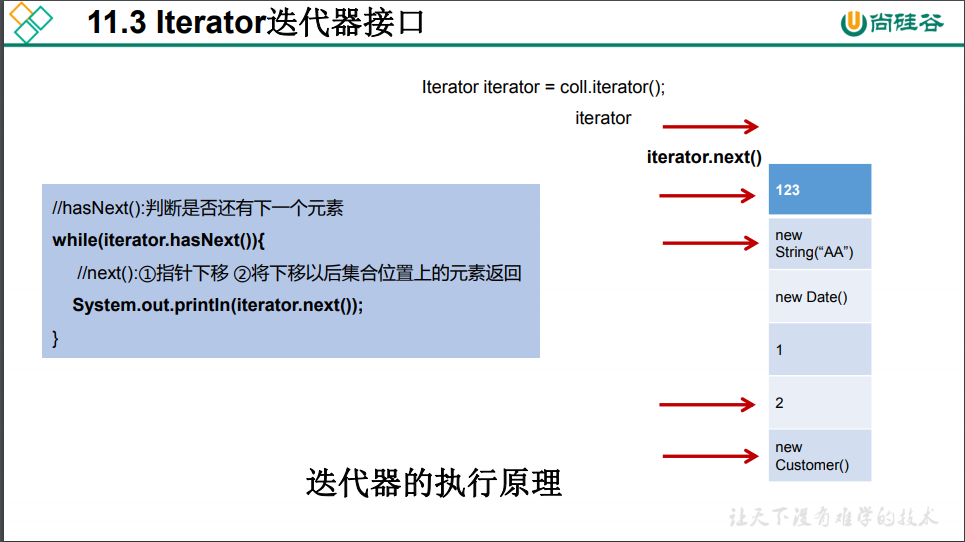

package com.atguigu.java; import org.junit.Test; import java.util.ArrayList; import java.util.Collection; import java.util.Iterator; /** * 集合元素的遍历操作,使用迭代器Iterator接口 * 1.内部的方法:hasNext() 和 next() * 2.集合对象每次调用iterator()方法都得到一个全新的迭代器对象, * 默认游标都在集合的第一个元素之前。 * 3.内部定义了remove(),可以在遍历的时候,删除集合中的元素。此方法不同于集合直接调用remove() * * @author shkstart * @create 2019 上午 10:44 */ public class IteratorTest { @Test public void test1(){ Collection coll = new ArrayList(); coll.add(123); coll.add(456); coll.add(new Person("Jerry",20)); coll.add(new String("Tom")); coll.add(false); Iterator iterator = coll.iterator(); //方式一: // System.out.println(iterator.next()); // System.out.println(iterator.next()); // System.out.println(iterator.next()); // System.out.println(iterator.next()); // System.out.println(iterator.next()); // //报异常:NoSuchElementException // System.out.println(iterator.next()); //方式二:不推荐 // for(int i = 0;i < coll.size();i++){ // System.out.println(iterator.next()); // } //方式三:推荐 ////hasNext():判断是否还有下一个元素 while(iterator.hasNext()){ //next():①指针下移 ②将下移以后集合位置上的元素返回 System.out.println(iterator.next()); } } @Test public void test2(){ Collection coll = new ArrayList(); coll.add(123); coll.add(456); coll.add(new Person("Jerry",20)); coll.add(new String("Tom")); coll.add(false); //错误方式一: // Iterator iterator = coll.iterator(); // while((iterator.next()) != null){ // System.out.println(iterator.next()); // } //错误方式二: //集合对象每次调用iterator()方法都得到一个全新的迭代器对象,默认游标都在集合的第一个元素之前。 while (coll.iterator().hasNext()){ System.out.println(coll.iterator().next()); } } //测试Iterator中的remove() //如果还未调用next()或在上一次调用 next 方法之后已经调用了 remove 方法, // 再调用remove都会报IllegalStateException。 @Test public void test3(){ Collection coll = new ArrayList(); coll.add(123); coll.add(456); coll.add(new Person("Jerry",20)); coll.add(new String("Tom")); coll.add(false); //删除集合中"Tom" Iterator iterator = coll.iterator(); while (iterator.hasNext()){ // iterator.remove(); Object obj = iterator.next(); if("Tom".equals(obj)){ iterator.remove(); // iterator.remove(); } } //遍历集合 iterator = coll.iterator(); while (iterator.hasNext()){ System.out.println(iterator.next()); } } }


package com.atguigu.java; import org.junit.Test; import java.util.ArrayList; import java.util.Collection; /** * jdk 5.0 新增了foreach循环,用于遍历集合、数组 * * @author shkstart * @create 2019 上午 11:24 */ public class ForTest { @Test public void test1(){ Collection coll = new ArrayList(); coll.add(123); coll.add(456); coll.add(new Person("Jerry",20)); coll.add(new String("Tom")); coll.add(false); //for(集合元素的类型 局部变量 : 集合对象) //内部仍然调用了迭代器。 for(Object obj : coll){ System.out.println(obj); } } @Test public void test2(){ int[] arr = new int[]{1,2,3,4,5,6}; //for(数组元素的类型 局部变量 : 数组对象) for(int i : arr){ System.out.println(i); } } //练习题 @Test public void test3(){ String[] arr = new String[]{"MM","MM","MM"}; // //方式一:普通for赋值 // for(int i = 0;i < arr.length;i++){ // arr[i] = "GG"; // } //方式二:增强for循环 for(String s : arr){ s = "GG"; } for(int i = 0;i < arr.length;i++){ System.out.println(arr[i]); } } }
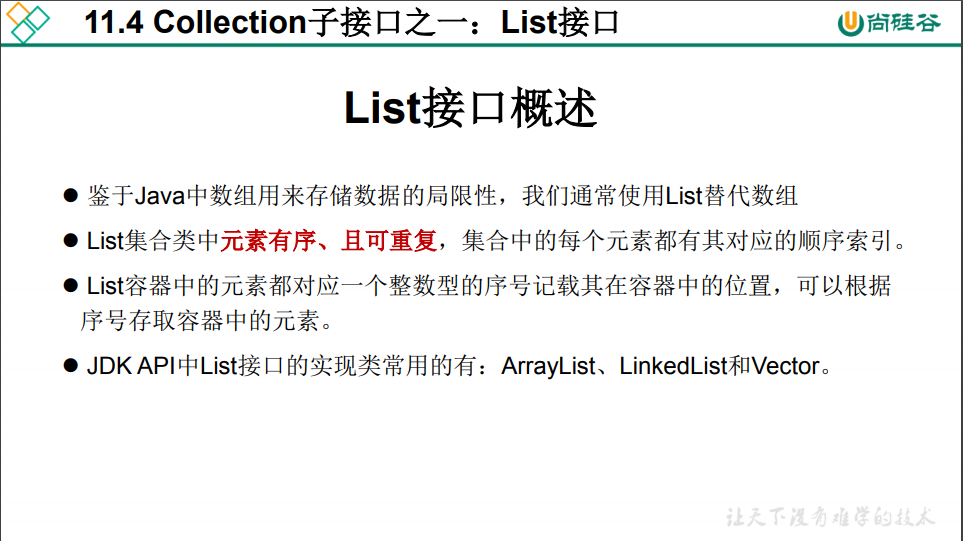

package com.atguigu.java; import org.junit.Test; import java.util.ArrayList; import java.util.Arrays; import java.util.Iterator; import java.util.List; /** * 1. List接口框架 * * |----Collection接口:单列集合,用来存储一个一个的对象 * |----List接口:存储有序的、可重复的数据。 -->“动态”数组,替换原有的数组 * |----ArrayList:作为List接口的主要实现类;线程不安全的,效率高;底层使用Object[] elementData存储 * |----LinkedList:对于频繁的插入、删除操作,使用此类效率比ArrayList高;底层使用双向链表存储 * |----Vector:作为List接口的古老实现类;线程安全的,效率低;底层使用Object[] elementData存储 * * * 2. ArrayList的源码分析: * 2.1 jdk 7情况下 * ArrayList list = new ArrayList();//底层创建了长度是10的Object[]数组elementData * list.add(123);//elementData[0] = new Integer(123); * ... * list.add(11);//如果此次的添加导致底层elementData数组容量不够,则扩容。 * 默认情况下,扩容为原来的容量的1.5倍,同时需要将原有数组中的数据复制到新的数组中。 * * 结论:建议开发中使用带参的构造器:ArrayList list = new ArrayList(int capacity) * * 2.2 jdk 8中ArrayList的变化: * ArrayList list = new ArrayList();//底层Object[] elementData初始化为{}.并没有创建长度为10的数组 * * list.add(123);//第一次调用add()时,底层才创建了长度10的数组,并将数据123添加到elementData[0] * ... * 后续的添加和扩容操作与jdk 7 无异。 * 2.3 小结:jdk7中的ArrayList的对象的创建类似于单例的饿汉式,而jdk8中的ArrayList的对象 * 的创建类似于单例的懒汉式,延迟了数组的创建,节省内存。 * * 3. LinkedList的源码分析: * LinkedList list = new LinkedList(); 内部声明了Node类型的first和last属性,默认值为null * list.add(123);//将123封装到Node中,创建了Node对象。 * * 其中,Node定义为:体现了LinkedList的双向链表的说法 * private static class Node<E> { E item; Node<E> next; Node<E> prev; Node(Node<E> prev, E element, Node<E> next) { this.item = element; this.next = next; this.prev = prev; } } * * 4. Vector的源码分析:jdk7和jdk8中通过Vector()构造器创建对象时,底层都创建了长度为10的数组。 * 在扩容方面,默认扩容为原来的数组长度的2倍。 * * 面试题:ArrayList、LinkedList、Vector三者的异同? * 同:三个类都是实现了List接口,存储数据的特点相同:存储有序的、可重复的数据 * 不同:见上 * * * * 5. List接口中的常用方法 * * @author shkstart * @create 2019 上午 11:39 */ public class ListTest { /* void add(int index, Object ele):在index位置插入ele元素 boolean addAll(int index, Collection eles):从index位置开始将eles中的所有元素添加进来 Object get(int index):获取指定index位置的元素 int indexOf(Object obj):返回obj在集合中首次出现的位置 int lastIndexOf(Object obj):返回obj在当前集合中末次出现的位置 Object remove(int index):移除指定index位置的元素,并返回此元素 Object set(int index, Object ele):设置指定index位置的元素为ele List subList(int fromIndex, int toIndex):返回从fromIndex到toIndex位置的子集合 总结:常用方法 增:add(Object obj) 删:remove(int index) / remove(Object obj) 改:set(int index, Object ele) 查:get(int index) 插:add(int index, Object ele) 长度:size() 遍历:① Iterator迭代器方式 ② 增强for循环 ③ 普通的循环 */ @Test public void test3(){ ArrayList list = new ArrayList(); list.add(123); list.add(456); list.add("AA"); //方式一:Iterator迭代器方式 Iterator iterator = list.iterator(); while(iterator.hasNext()){ System.out.println(iterator.next()); } System.out.println("***************"); //方式二:增强for循环 for(Object obj : list){ System.out.println(obj); } System.out.println("***************"); //方式三:普通for循环 for(int i = 0;i < list.size();i++){ System.out.println(list.get(i)); } } @Test public void test2(){ ArrayList list = new ArrayList(); list.add(123); list.add(456); list.add("AA"); list.add(new Person("Tom",12)); list.add(456); //int indexOf(Object obj):返回obj在集合中首次出现的位置。如果不存在,返回-1. int index = list.indexOf(4567); System.out.println(index); //int lastIndexOf(Object obj):返回obj在当前集合中末次出现的位置。如果不存在,返回-1. System.out.println(list.lastIndexOf(456)); //Object remove(int index):移除指定index位置的元素,并返回此元素 Object obj = list.remove(0); System.out.println(obj); System.out.println(list); //Object set(int index, Object ele):设置指定index位置的元素为ele list.set(1,"CC"); System.out.println(list); //List subList(int fromIndex, int toIndex):返回从fromIndex到toIndex位置的左闭右开区间的子集合 List subList = list.subList(2, 4); System.out.println(subList); System.out.println(list); } @Test public void test1(){ ArrayList list = new ArrayList(); list.add(123); list.add(456); list.add("AA"); list.add(new Person("Tom",12)); list.add(456); System.out.println(list); //void add(int index, Object ele):在index位置插入ele元素 list.add(1,"BB"); System.out.println(list); //boolean addAll(int index, Collection eles):从index位置开始将eles中的所有元素添加进来 List list1 = Arrays.asList(1, 2, 3); list.addAll(list1); // list.add(list1); System.out.println(list.size());//9 //Object get(int index):获取指定index位置的元素 System.out.println(list.get(0)); } }
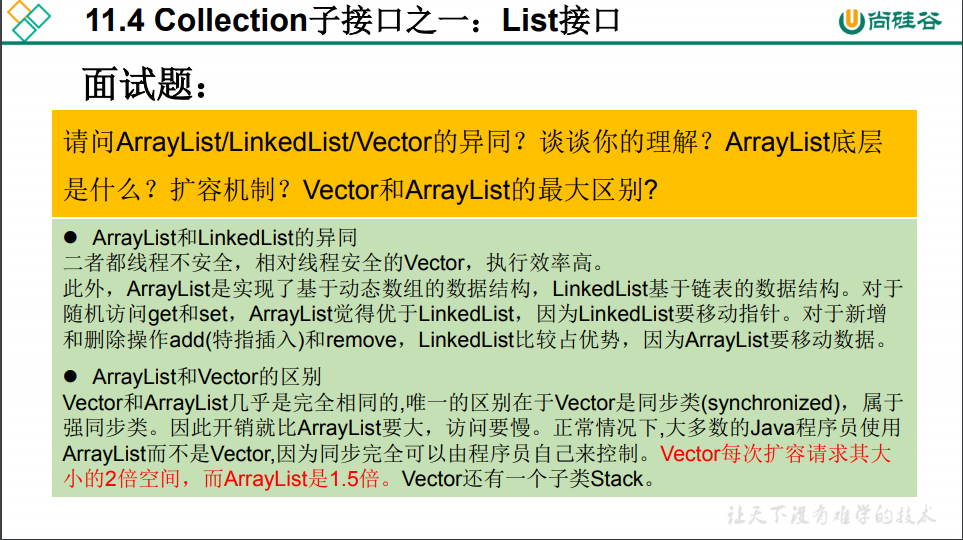
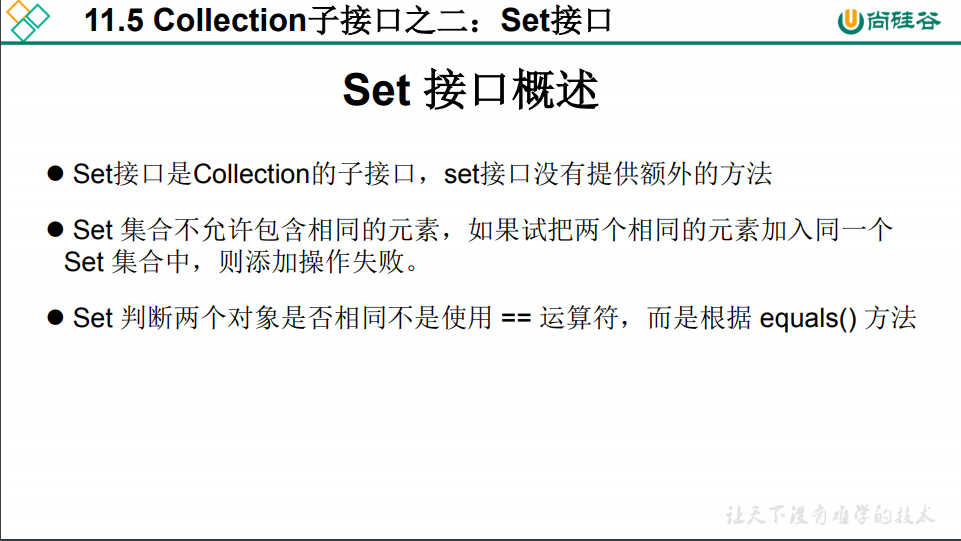

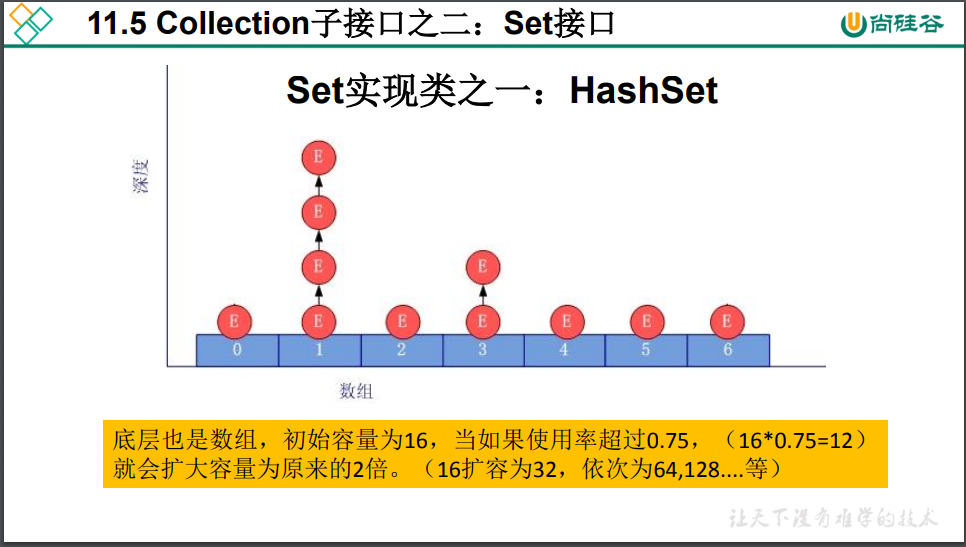


package com.atguigu.java1; import org.junit.Test; import java.util.HashSet; import java.util.Iterator; import java.util.LinkedHashSet; import java.util.Set; /** * 1. Set接口的框架: * * |----Collection接口:单列集合,用来存储一个一个的对象 * |----Set接口:存储无序的、不可重复的数据 -->高中讲的“集合” * |----HashSet:作为Set接口的主要实现类;线程不安全的;可以存储null值 * |----LinkedHashSet:作为HashSet的子类;遍历其内部数据时,可以按照添加的顺序遍历 * 对于频繁的遍历操作,LinkedHashSet效率高于HashSet. * |----TreeSet:可以按照添加对象的指定属性,进行排序。 * * * 1. Set接口中没有额外定义新的方法,使用的都是Collection中声明过的方法。 * * 2. 要求:向Set(主要指:HashSet、LinkedHashSet)中添加的数据,其所在的类一定要重写hashCode()和equals() * 要求:重写的hashCode()和equals()尽可能保持一致性:相等的对象必须具有相等的散列码 * 重写两个方法的小技巧:对象中用作 equals() 方法比较的 Field,都应该用来计算 hashCode 值。 * * * @author shkstart * @create 2019 下午 3:40 */ public class SetTest { /* 一、Set:存储无序的、不可重复的数据 以HashSet为例说明: 1. 无序性:不等于随机性。存储的数据在底层数组中并非按照数组索引的顺序添加,而是根据数据的哈希值决定的。 2. 不可重复性:保证添加的元素按照equals()判断时,不能返回true.即:相同的元素只能添加一个。 二、添加元素的过程:以HashSet为例: 我们向HashSet中添加元素a,首先调用元素a所在类的hashCode()方法,计算元素a的哈希值, 此哈希值接着通过某种算法计算出在HashSet底层数组中的存放位置(即为:索引位置),判断 数组此位置上是否已经有元素: 如果此位置上没有其他元素,则元素a添加成功。 --->情况1 如果此位置上有其他元素b(或以链表形式存在的多个元素),则比较元素a与元素b的hash值: 如果hash值不相同,则元素a添加成功。--->情况2 如果hash值相同,进而需要调用元素a所在类的equals()方法: equals()返回true,元素a添加失败 equals()返回false,则元素a添加成功。--->情况2 对于添加成功的情况2和情况3而言:元素a 与已经存在指定索引位置上数据以链表的方式存储。 jdk 7 :元素a放到数组中,指向原来的元素。 jdk 8 :原来的元素在数组中,指向元素a 总结:七上八下 HashSet底层:数组+链表的结构。 */ @Test public void test1(){ Set set = new HashSet(); set.add(456); set.add(123); set.add(123); set.add("AA"); set.add("CC"); set.add(new User("Tom",12)); set.add(new User("Tom",12)); set.add(129); Iterator iterator = set.iterator(); while(iterator.hasNext()){ System.out.println(iterator.next()); } } //LinkedHashSet的使用 //LinkedHashSet作为HashSet的子类,在添加数据的同时,每个数据还维护了两个引用,记录此数据前一个 //数据和后一个数据。 //优点:对于频繁的遍历操作,LinkedHashSet效率高于HashSet @Test public void test2(){ Set set = new LinkedHashSet(); set.add(456); set.add(123); set.add(123); set.add("AA"); set.add("CC"); set.add(new User("Tom",12)); set.add(new User("Tom",12)); set.add(129); Iterator iterator = set.iterator(); while(iterator.hasNext()){ System.out.println(iterator.next()); } } }


package com.atguigu.java1; import org.junit.Test; import java.util.Comparator; import java.util.Iterator; import java.util.TreeSet; /** * @author shkstart * @create 2019 下午 4:59 */ public class TreeSetTest { /* 1.向TreeSet中添加的数据,要求是相同类的对象。 2.两种排序方式:自然排序(实现Comparable接口) 和 定制排序(Comparator) 3.自然排序中,比较两个对象是否相同的标准为:compareTo()返回0.不再是equals(). 4.定制排序中,比较两个对象是否相同的标准为:compare()返回0.不再是equals(). */ @Test public void test1(){ TreeSet set = new TreeSet(); //失败:不能添加不同类的对象 // set.add(123); // set.add(456); // set.add("AA"); // set.add(new User("Tom",12)); //举例一: // set.add(34); // set.add(-34); // set.add(43); // set.add(11); // set.add(8); //举例二: set.add(new User("Tom",12)); set.add(new User("Jerry",32)); set.add(new User("Jim",2)); set.add(new User("Mike",65)); set.add(new User("Jack",33)); set.add(new User("Jack",56)); Iterator iterator = set.iterator(); while(iterator.hasNext()){ System.out.println(iterator.next()); } } @Test public void test2(){ Comparator com = new Comparator() { //按照年龄从小到大排列 @Override public int compare(Object o1, Object o2) { if(o1 instanceof User && o2 instanceof User){ User u1 = (User)o1; User u2 = (User)o2; return Integer.compare(u1.getAge(),u2.getAge()); }else{ throw new RuntimeException("输入的数据类型不匹配"); } } }; TreeSet set = new TreeSet(com); set.add(new User("Tom",12)); set.add(new User("Jerry",32)); set.add(new User("Jim",2)); set.add(new User("Mike",65)); set.add(new User("Mary",33)); set.add(new User("Jack",33)); set.add(new User("Jack",56)); Iterator iterator = set.iterator(); while(iterator.hasNext()){ System.out.println(iterator.next()); } } }

package com.atguigu.java1; /** * @author shkstart * @create 2019 下午 3:56 */ public class User implements Comparable{ private String name; private int age; public User() { } public User(String name, int age) { this.name = name; this.age = age; } public String getName() { return name; } public void setName(String name) { this.name = name; } public int getAge() { return age; } public void setAge(int age) { this.age = age; } @Override public String toString() { return "User{" + "name='" + name + '\'' + ", age=" + age + '}'; } @Override public boolean equals(Object o) { System.out.println("User equals()...."); if (this == o) return true; if (o == null || getClass() != o.getClass()) return false; User user = (User) o; if (age != user.age) return false; return name != null ? name.equals(user.name) : user.name == null; } @Override public int hashCode() { //return name.hashCode() + age; int result = name != null ? name.hashCode() : 0; result = 31 * result + age; return result; } //按照姓名从大到小排列,年龄从小到大排列 @Override public int compareTo(Object o) { if(o instanceof User){ User user = (User)o; // return -this.name.compareTo(user.name); int compare = -this.name.compareTo(user.name); if(compare != 0){ return compare; }else{ return Integer.compare(this.age,user.age); } }else{ throw new RuntimeException("输入的类型不匹配"); } } }
-------------------课后练习----------------------

package com.atguigu.exer; import org.junit.Test; import java.util.ArrayList; import java.util.Collection; import java.util.HashSet; import java.util.List; /** * @author shkstart * @create 2019 上午 9:36 */ public class CollectionTest { @Test public void test1(){ Collection coll = new ArrayList(); coll.add(123); coll.add(456); coll.add(343); coll.add(343); coll.forEach(System.out::println); } //练习:在List内去除重复数字值,要求尽量简单 public static List duplicateList(List list) { HashSet set = new HashSet(); set.addAll(list); return new ArrayList(set); } @Test public void test2(){ List list = new ArrayList(); list.add(new Integer(1)); list.add(new Integer(2)); list.add(new Integer(2)); list.add(new Integer(4)); list.add(new Integer(4)); List list2 = duplicateList(list); for (Object integer : list2) { System.out.println(integer); } } @Test public void test3(){ HashSet set = new HashSet(); Person p1 = new Person(1001,"AA"); Person p2 = new Person(1002,"BB"); set.add(p1); set.add(p2); System.out.println(set); p1.name = "CC"; set.remove(p1); System.out.println(set); set.add(new Person(1001,"CC")); System.out.println(set); set.add(new Person(1001,"AA")); System.out.println(set); } }

package com.atguigu.exer; /** * @author shkstart * @create 2019 上午 10:50 */ public class Person { int id; String name; public Person(int id, String name) { this.id = id; this.name = name; } public Person() { } @Override public String toString() { return "Person{" + "id=" + id + ", name='" + name + '\'' + '}'; } @Override public boolean equals(Object o) { if (this == o) return true; if (o == null || getClass() != o.getClass()) return false; Person person = (Person) o; if (id != person.id) return false; return name != null ? name.equals(person.name) : person.name == null; } @Override public int hashCode() { int result = id; result = 31 * result + (name != null ? name.hashCode() : 0); return result; } }
-------------------------2--------------------------

package com.atguigu.exer1; /** * 定义一个Employee类。 该类包含:private成员变量name,age,birthday,其中 birthday 为 MyDate 类的对象; 并为每一个属性定义 getter, setter 方法; 并重写 toString 方法输出 name, age, birthday * @author shkstart * @create 2019 上午 10:22 */ public class Employee implements Comparable{ private String name; private int age; private MyDate birthday; public Employee(String name, int age, MyDate birthday) { this.name = name; this.age = age; this.birthday = birthday; } public Employee() { } public String getName() { return name; } public void setName(String name) { this.name = name; } public int getAge() { return age; } public void setAge(int age) { this.age = age; } public MyDate getBirthday() { return birthday; } public void setBirthday(MyDate birthday) { this.birthday = birthday; } @Override public String toString() { return "Employee{" + "name='" + name + '\'' + ", age=" + age + ", birthday=" + birthday + '}'; } //按 name 排序 @Override public int compareTo(Object o) { if(o instanceof Employee){ Employee e = (Employee)o; return this.name.compareTo(e.name); } // return 0; throw new RuntimeException("传入的数据类型不一致!"); } }

package com.atguigu.exer1; import org.junit.Test; import java.util.Comparator; import java.util.Iterator; import java.util.TreeSet; /** * 创建该类的 5 个对象,并把这些对象放入 TreeSet 集合中(下一章:TreeSet 需使用泛型来定义) 分别按以下两种方式对集合中的元素进行排序,并遍历输出: 1). 使Employee 实现 Comparable 接口,并按 name 排序 2). 创建 TreeSet 时传入 Comparator对象,按生日日期的先后排序。 * * @author shkstart * @create 2019 上午 10:23 */ public class EmployeeTest { //问题二:按生日日期的先后排序。 @Test public void test2(){ TreeSet set = new TreeSet(new Comparator() { @Override public int compare(Object o1, Object o2) { if(o1 instanceof Employee && o2 instanceof Employee){ Employee e1 = (Employee)o1; Employee e2 = (Employee)o2; MyDate b1 = e1.getBirthday(); MyDate b2 = e2.getBirthday(); //方式一: // //比较年 // int minusYear = b1.getYear() - b2.getYear(); // if(minusYear != 0){ // return minusYear; // } // //比较月 // int minusMonth = b1.getMonth() - b2.getMonth(); // if(minusMonth != 0){ // return minusMonth; // } // //比较日 // return b1.getDay() - b2.getDay(); //方式二: return b1.compareTo(b2); } // return 0; throw new RuntimeException("传入的数据类型不一致!"); } }); Employee e1 = new Employee("liudehua",55,new MyDate(1965,5,4)); Employee e2 = new Employee("zhangxueyou",43,new MyDate(1987,5,4)); Employee e3 = new Employee("guofucheng",44,new MyDate(1987,5,9)); Employee e4 = new Employee("liming",51,new MyDate(1954,8,12)); Employee e5 = new Employee("liangzhaowei",21,new MyDate(1978,12,4)); set.add(e1); set.add(e2); set.add(e3); set.add(e4); set.add(e5); Iterator iterator = set.iterator(); while (iterator.hasNext()){ System.out.println(iterator.next()); } } //问题一:使用自然排序 @Test public void test1(){ TreeSet set = new TreeSet(); Employee e1 = new Employee("liudehua",55,new MyDate(1965,5,4)); Employee e2 = new Employee("zhangxueyou",43,new MyDate(1987,5,4)); Employee e3 = new Employee("guofucheng",44,new MyDate(1987,5,9)); Employee e4 = new Employee("liming",51,new MyDate(1954,8,12)); Employee e5 = new Employee("liangzhaowei",21,new MyDate(1978,12,4)); set.add(e1); set.add(e2); set.add(e3); set.add(e4); set.add(e5); Iterator iterator = set.iterator(); while (iterator.hasNext()){ System.out.println(iterator.next()); } } }

package com.atguigu.exer1; /** * MyDate类包含: private成员变量year,month,day;并为每一个属性定义 getter, setter 方法; * @author shkstart * @create 2019 上午 10:21 */ public class MyDate implements Comparable{ private int year; private int month; private int day; public MyDate(int year, int month, int day) { this.year = year; this.month = month; this.day = day; } public MyDate() { } public int getYear() { return year; } public void setYear(int year) { this.year = year; } public int getMonth() { return month; } public void setMonth(int month) { this.month = month; } public int getDay() { return day; } public void setDay(int day) { this.day = day; } @Override public String toString() { return "MyDate{" + "year=" + year + ", month=" + month + ", day=" + day + '}'; } @Override public int compareTo(Object o) { if(o instanceof MyDate){ MyDate m = (MyDate)o; //比较年 int minusYear = this.getYear() - m.getYear(); if(minusYear != 0){ return minusYear; } //比较月 int minusMonth = this.getMonth() - m.getMonth(); if(minusMonth != 0){ return minusMonth; } //比较日 return this.getDay() - m.getDay(); } throw new RuntimeException("传入的数据类型不一致!"); } }




 浙公网安备 33010602011771号
浙公网安备 33010602011771号